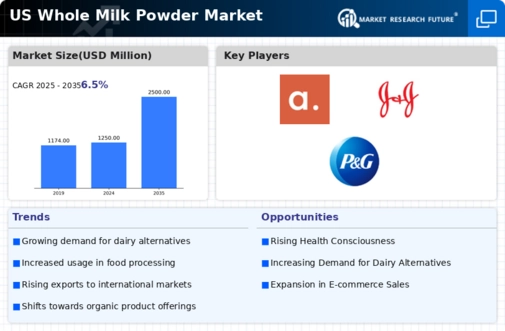Growing Export Opportunities
It is poised to benefit from growing export opportunities. As international demand for dairy products continues to rise, US producers may find lucrative markets abroad. Countries in Asia and the Middle East are increasingly importing dairy products, including whole milk-powder, to meet their domestic consumption needs. In 2025, US dairy exports are expected to exceed $7 billion, with whole milk-powder comprising a significant portion of this figure. This trend suggests that US producers could capitalize on global market dynamics, enhancing their competitiveness and profitability in the whole milk-powder market.
Increased Use in Food Manufacturing
It benefits from increased utilization in food manufacturing. As food producers seek to enhance the nutritional profile of their products, whole milk-powder serves as a valuable ingredient in various applications, including baked goods, sauces, and infant formula. The US food manufacturing sector is projected to grow at a CAGR of 3.5% through 2025, which may further bolster the demand for whole milk-powder. This trend indicates a potential for whole milk-powder producers to establish long-term partnerships with food manufacturers, thereby securing a stable revenue stream and expanding their market presence.
Rising Demand for Dairy Alternatives
The whole milk-powder market experiences a notable increase in demand due to the rising popularity of dairy alternatives. Consumers are increasingly seeking products that align with their dietary preferences, including lactose-free and plant-based options. This shift is likely to influence the whole milk-powder market, as manufacturers may adapt their offerings to cater to this trend. In 2025, the market for dairy alternatives in the US is projected to reach approximately $5 billion, indicating a significant opportunity for whole milk-powder producers to innovate and diversify their product lines. The growing awareness of health benefits associated with dairy consumption may also drive interest in whole milk-powder as a versatile ingredient in various food applications.
Technological Advancements in Processing
Technological advancements in processing techniques are transforming the whole milk-powder market. Innovations such as spray drying and advanced filtration methods enhance the quality and shelf life of milk powder products. These improvements not only ensure better nutrient retention but also reduce production costs, making whole milk-powder more accessible to consumers. In 2025, the US dairy processing industry is expected to invest over $1 billion in new technologies, which could significantly impact the whole milk-powder market. Enhanced processing capabilities may lead to the development of specialized products, catering to niche markets and increasing overall market competitiveness.
Consumer Preferences for Convenience Foods
It is influenced by changing consumer preferences for convenience foods. As busy lifestyles become more prevalent, consumers are gravitating towards products that offer ease of preparation and versatility. Whole milk-powder serves as a convenient alternative to liquid milk, allowing for easy incorporation into various recipes without the need for refrigeration. The convenience food market in the US is projected to grow by 4% annually through 2025, indicating a favorable environment for whole milk-powder products. This trend may encourage manufacturers to develop ready-to-use formulations that cater to the needs of time-constrained consumers, thereby expanding the market's reach.














Leave a Comment